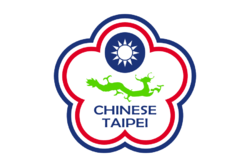- Chinese Taipei Olympic flag
-
The Chinese Taipei Olympic flag is used by Republic of China (ROC) team — commonly known as Taiwan — which competes under the title "Chinese Taipei," during the Olympic Games instead of the flag of the Republic of China. The Olympic flag has been in use since 1980, following a decision by the International Olympic Committee that the ROC could not compete under the ROC name or flag.
Contents
Court case over IOC decision
In October 1979 the IOC ruled that the “Republic of China Olympic Committee” would have to change its name to the “Chinese Taipei Olympic Committee” and adopt a new flag and anthem if it wanted to participate in the Olympic Games. The ROC strongly disagreed with the decision and sued the IOC in Switzerland.[1] The ROC claimed that the conditions concerning its name, flag and anthem violated articles 6, 64, and 66 of the IOC charter. However, despite appealing an initial Court judgment, the ROC was not successful. On 15 January 1980, a Swiss court rejected Taiwan's efforts to stay in the Olympic movement under the name "Republic of China".[2][3][4]
Design and symbolism
The flag shows the Blue Sky with a White Sun, which is the National Emblem of the Republic of China. It is also the emblem of the Kuomintang and the canton of the flag of the Republic of China. The twelve rays of the white Sun representing the twelve months and the twelve traditional Chinese hours (simplified Chinese: 时辰; traditional Chinese: 時辰; pinyin: shíchen), each of which corresponds to two modern hours (simplified Chinese: 小时; traditional Chinese: 小時; pinyin: xiǎoshí; literally "little hour") and symbolizes the spirit of progress.[5] Below the blue and white symbol, appears the Olympic flag, which in words of Pierre de Coubertin, the father of the modern Olympic Games, has a meaning: "The Olympic flag has a white background, with five interlaced rings in the centre: blue, yellow, black, green and red. This design is symbolic; it represents the five continents of the world, united by Olympism, while the six colours are those that appear on all the national flags of the world at the present time" (this was in written in 1931).[6] Encircling these two symbols, we can see the National Flower of the Republic of China, the five-petaled plum blossom, Prunus mei. It has 5 characteristic petals, colored with red, white and blue, the colors of the flag of the Republic of China.[7] The Paralympic version of the flag is identical, but replaces the Olympic rings with the red, green, and blue logo of the International Paralympic Committee.
Chinese Taipei Paralympic flag
Together with the Blue Sky with a White Sun, the emblem of the Republic of China and the five petaled Prunus Mei, the design displays three agitos encircling an invisible central point, which is the new Paralympic flag. This new Paralympic Symbol consists of three elements in red, blue and green (the three colours that are most widely represented in national flags around the world at the time of its design, which was in April 2003). It is a symbol that is in motion, with three Agitos (from the Latin word "agito", meaning "I move") encircling a central point.[8]
Chinese Taipei Deaflympic flag
Together with the Blue Sky with a White Sun, the emblem of the Republic of China and the five petaled Prunus Mei, the design displays a green dragon with the name Chinese Taipei down.
Chinese Taipei Football flag
The design of this flag is similar to the Chinese Taipei Olympic flag. It replaces the five Olympic rings with the taijitu, the yin and yang symbol. In this case, both the white and black circular shapes inside the taijitsu are substituted by soccer balls.
Chinese Taipei University Sports flag
Together with the Blue Sky with a White Sun, the emblem of the Republic of China and the five petaled Prunus Mei, the design displays the letter U encircling an invisible central point, which is the FISU symbol. However, the flag color is electric blue.
See also
Politics of the Republic of China (Taiwan) Doctrines 
Government BranchesExecutive (Premier) · Legislative (Speaker) · Judicial · Control · Examination · Defunct: National AssemblyLeadershipParties OthersElections PresidentialLegislativeNational AssemblyCross-Strait Foreign affairs United Nations · Chinese Taipei · India · Japan · Paraguay · Singapore · South Korea · United States · VenezuelaOther topics StatusPolitical · LegalIssuesReferences
- ^ The Times, November 24, 1979
- ^ The Times, January 17, 1980
- ^ "Taiwan requests meets court folly; Swiss gives Peking go-ahead". The Spokesman Review. 1980-01-16. http://news.google.com/newspapers?nid=1314&dat=19800116&id=CcspAAAAIBAJ&sjid=3u4DAAAAIBAJ&pg=4833,503720. Retrieved 2011-09-23.
- ^ "Swiss court dismisses Taiwan case". Bangor Daily News. 1980-01-16. http://news.google.com/newspapers?nid=2457&dat=19800116&id=nIQ-AAAAIBAJ&sjid=CloMAAAAIBAJ&pg=2062,169055. Retrieved 2011-09-23.
- ^ "ROC National Flag". Government Information Office of the Republic of China. 2007-04-12. http://www.gio.gov.tw/ct.asp?xItem=18691&CtNode=2579&mp=807.
- ^ "The Olympic Flag". The official website of the Beijing 2008 Olympic Games. 2008-07-14. http://en.beijing2008.cn/spirit/symbols/flag/index.shtml.
- ^ "National Flower of the Republic of China". Government Information Office of the Republic of China. 2007-04-12. http://www.gio.gov.tw/ct.asp?xItem=18693&CtNode=2579&mp=807.
- ^ "Paralympic Symbol and Motto". International Paralympic Committee. 2008-09-07. http://www.paralympic.org/release/Main_Sections_Menu/IPC/About_the_IPC/IPC_Symbol_and_Motto/.
Categories:- Flags of the Republic of China
Wikimedia Foundation. 2010.






